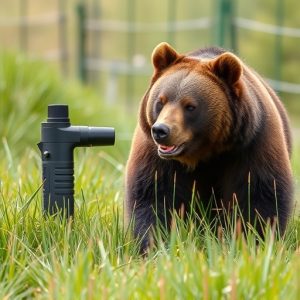Alaska Bear Repellent: Maximizing Range Against Charged Grizzlies
Bear spray, a non-lethal deterrent designed for close encounters with aggressive grizzlies, uses cap…….
Bear spray, a non-lethal deterrent designed for close encounters with aggressive grizzlies, uses capsaicin to create an irritant barrier. Effective up to 20-40 feet (6-12 meters), its utility diminishes against charging bears that approach within 15-30 feet (4.5-9 meters). Weather and chemical composition impact performance, highlighting the need for close-range repellents when facing grizzlies. Choosing the right bear spray and understanding deployment techniques are crucial for safe navigation in Alaska's wild terrain.
“In the vast wilderness of Alaska, encountering a charging grizzly bear is a stark reality for outdoor enthusiasts. Understanding the effectiveness of bear spray, specifically its maximum range, is crucial for survival. This article navigates the world of bear repellent, delving into the science behind bear spray and how it stacks up against these formidable creatures. From the power of a charged grizzly to choosing the right gear, we explore factors influencing performance, ensuring you’re prepared in Alaska’s unpredictable environment.”
- Understanding Bear Spray: What It Is and How It Works
- The Power of a Charged Grizzly Bear: A Force to Reckon With
- Comparing Bear Spray Ranges: Uncovering the Maximum Effective Distance
- Factors Influencing Bear Repellent Performance
- Choosing the Right Bear Spray for Alaska's Wilderness
Understanding Bear Spray: What It Is and How It Works
Bear spray, also known as bear repellent, is a powerful tool for personal safety in areas where bears are present. It’s a specialized type of pepper spray designed to deter and disperse aggressive bears, particularly grizzlies. Unlike traditional pepper spray used for self-defense against humans, bear spray is formulated to be less harmful to the user while still effectively incapacitating a bear.
When facing an approaching grizzly bear, understanding the dynamics between bear spray and its effectiveness becomes crucial. Bear spray creates a barrier of capsaicin, the active ingredient, which irritates the bear’s eyes, nose, and respiratory system. This causes the bear to back away and often flee from the area. In contrast, if a bear charges, it indicates extreme aggression and may suggest that the spray is not effective at this range. Bear spray is most useful when bears detect you first and are within the recommended 70-foot (21 meter) maximum range for optimal effectiveness.
The Power of a Charged Grizzly Bear: A Force to Reckon With
In Alaska, encountering a charging grizzly bear is an extremely formidable challenge, underscoring the state’s unique and untamed wilderness. These powerful beasts are capable of running at speeds up to 30 miles per hour (48 km/h) for short bursts, making them incredibly fast and unpredictable. When faced with a potential threat, a grizzly’s first response is often a charge—a display of dominance and an attempt to intimidate. Their massive size, sharp claws, and powerful jaws make them formidable opponents.
In such high-stakes situations, the choice between bear spray and other deterrents becomes critical. Bear spray, specifically designed for repelling bears, offers a non-lethal but effective solution when used correctly within its maximum range. Unlike in movies or folklore, simply seeing a grizzly charge is not always an immediate death sentence. Understanding the bear’s behavior and using appropriate repellents like bear spray, which can be effective up to 20 feet (6 meters) away, can make a significant difference in outcomes for both humans and bears.
Comparing Bear Spray Ranges: Uncovering the Maximum Effective Distance
When considering bear repellent options, understanding the maximum range of your chosen product is paramount, especially in Alaska’s vast wilderness where both black bears and charging grizzlies roam. Bear spray, a popular choice for outdoor enthusiasts, offers varying effective distances depending on several factors like can size, air pressure, and user technique. Typically, standard-sized cans project a spray pattern about 30 feet (9 meters) in ideal conditions. However, when comparing bear spray to its effectiveness against charging grizzlies, it’s crucial to note that these powerful predators often approach within much closer ranges—sometimes as low as 15 feet (4.5 meters)—requiring users to deploy the spray at very close proximity.
To illustrate the point, consider that a spray can with a claimed maximum range of 30 feet may still prove ineffective against an aggressive grizzly bear if the user is not able to activate the spray in time. In contrast, bear spray vs. charging grizzly bears reveals that the former’s maximum effective distance pales in comparison to the latter’s swift and powerful movements. Thus, alaskans and visitors alike must choose repellents designed for close-range use and practice proper deployment techniques to maximize their safety in bear country.
Factors Influencing Bear Repellent Performance
When comparing bear spray to a charging grizzly bear, understanding the factors that influence repellent performance is key. The effectiveness of any bear deterrent depends on several variables, including the specific chemical composition of the repellent, weather conditions, and distance from the bear. Bear spray, for instance, works best in close proximity, typically up to 40 feet (12 meters), as it creates a barrier of chemicals that can temporarily disable a bear’s sense of smell and vision.
In contrast, charging grizzlies pose an immediate physical threat at closer ranges, often within 30 feet (9 meters). While bear spray can provide valuable time to escape or play dead, it may not stop a determined charge. The spray’s effectiveness diminishes with wind or rain, which can quickly disperse the chemicals, leaving the user vulnerable. Thus, choosing the right repellent depends on the specific scenario and understanding the maximum ranges and limitations of each method.
Choosing the Right Bear Spray for Alaska's Wilderness
When venturing into Alaska’s wilderness, selecting the appropriate bear repellent is paramount for your safety. One common option is bear spray, a powerful tool designed to deter aggressive bears like grizzlies when used correctly. Unlike traditional cologne or deodorant sprays, bear spray contains capsaicin, the active ingredient found in chili peppers, which can effectively create a barrier between you and the bear.
Understanding the differences between bear spray and facing a charging grizzly is crucial. Bear spray is intended for defensive purposes, designed to give you time to retreat and avoid an attack. When used from a safe distance—typically recommended as 20-30 feet (6-9 meters)—it can deter a bear from approaching further. In contrast, direct confrontation or trying to outrun a grizzly is not advisable; it’s the unpredictable nature of their behavior that makes Alaska’s wilderness both beautiful and dangerous.
When venturing into Alaska’s wilderness, understanding the maximum range of bear repellent is crucial for your safety. This article has explored the power of a charged grizzly bear and the importance of bear spray as a defense mechanism. Comparing different spray ranges highlights the key factors that influence their effectiveness, such as wind, terrain, and distance. Choosing the right bear spray, designed specifically for Alaska’s conditions, ensures you’re prepared should you encounter a charging grizzly. Remember, knowledge and the right equipment can make all the difference in these remote environments.

